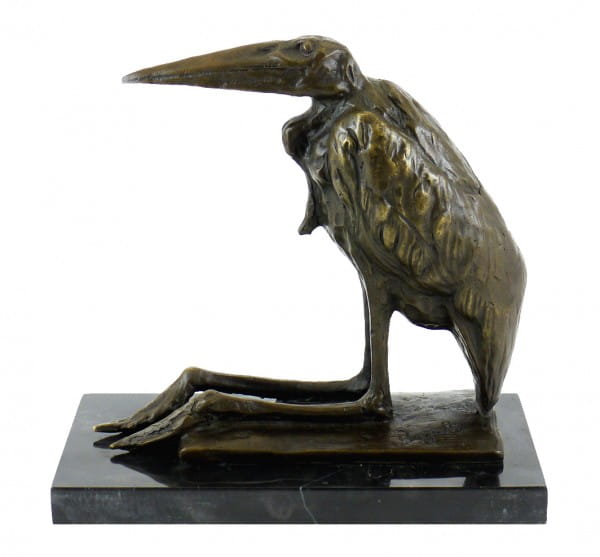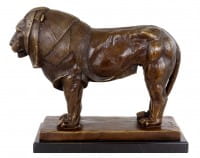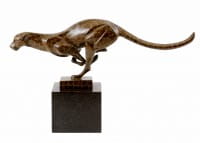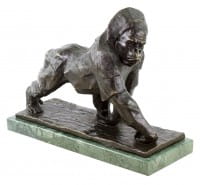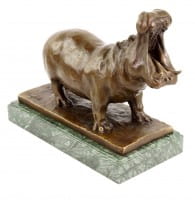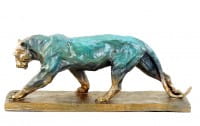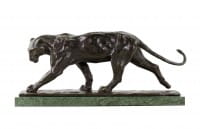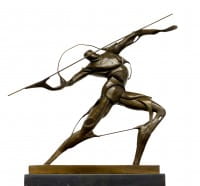Prices incl. VAT, free shipping worldwide
Ready to ship today,
Delivery time appr. 3-6 workdays










Product description
"Rembrandt Bugatti Sculptures - Marabou Stork - signed"
| Weight | 2,1 kg |
Bronze Bird - Marabou Stork - Signed Rembrandt Bugatti
Rembrandt Bugatti was born on October 16, 1884, in Milan, Italy, into a family steeped in creative and technical brilliance. His father, Carlo Bugatti, was a celebrated Art Nouveau designer, and his older brother, Ettore Bugatti, would become a legendary figure in automotive history. But it was Rembrandt who developed a deep, introspective relationship with the animal world. From an early age, he preferred the company of animals to that of people. Observing, sketching, and modeling them from life became his life’s passion. His visits to the zoos of Milan, Antwerp, and Paris formed the foundation of what would become a body of work unmatched in sensitivity and expressive power. Within the canon of Rembrandt Bugatti sculptures, it is his birds and large mammals that most hauntingly communicate his emotional affinity with nature.
A Singular Subject with Unusual Presence
The “Marabou Stork”, cast in bronze and signed by the artist, is one of the more quietly remarkable examples of Rembrandt Bugatti. It shows the bird in a seated, anthropomorphic pose—its impossibly long legs stretched out before it, while its torso remains upright, weight shifted naturally forward, and the head turned with what appears to be exhausted indifference or solemn reflection. This posture is not theatrical. It is observational, a position Bugatti likely witnessed firsthand in the zoo and then translated with all the immediacy of his modeling style. In this moment of repose, the marabou stork becomes a character—a living presence suspended between nature and sculpture.
A Language Carved in Gesture and Form
Bugatti’s modeling technique is unmistakable. Working in plastiline clay directly before his animal subjects, he left expressive, tactile marks in the surface—evidence of movement, mood, and mass. The Marabou Stork carries this sculptural energy: the loose, coarse treatment of the feathers conveys the oily texture and irregularity of the bird’s plumage, while the sharp plane of the beak and the gnarled length of the legs articulate both physicality and fragility. This is where Rembrandt Bugatti sculptures excel—not in clinical precision, but in an emotional realism that transcends anatomy. The result is not just a likeness, but a soul in bronze.
Emotion, Not Sentimentality
There is a quiet melancholy in the Marabou Stork, a mood that echoes Bugatti’s own temperament. He was known for his introversion and hypersensitivity—traits that filtered into his art. The seated stork does not entertain or idealize; it simply is. It possesses that rare quality of animal presence Bugatti understood so well: dignity without vanity, beauty without artifice. Unlike the romanticized animal sculptures of the 19th century, Rembrandt Bugatti sculptures reject anthropomorphism while still acknowledging emotional expression. In the heavy stillness of the bird’s posture lies a depth of feeling that makes this work resonate on a deeply human level.
The Artist’s World in Antwerp
This sculpture likely dates to Bugatti’s years in Antwerp, between 1907 and 1914, when he was working closely with the Antwerp Zoo. There, he had intimate access to hundreds of species, including large African birds such as marabou storks. He often sculpted them on site, surrounded by the sounds and smells of the enclosures, capturing their idiosyncrasies and postures from life. These works, created far from the salons of Paris, show a sculptor immersed in the rhythms of nonhuman life. The Marabou Stork belongs to this important period in Rembrandt Bugatti sculptures, a time when his work moved beyond the decorative and toward something essential and meditative.
A Signature That Carries Weight
The base of the sculpture bears Bugatti’s name—not as mere identification, but as a seal of a life devoted to artistic and ethical precision. Each Rembrandt Bugatti bronze is the result of direct encounter, rapid modeling, and carefully supervised casting. No element was outsourced, and no animal was ever idealized or misrepresented. The Marabou Stork reflects this standard. Its odd pose, elongated proportions, and weary elegance are sculpted truths, drawn from life with the eye of a naturalist and the hand of a poet.
A Life Brief but Brilliant
Rembrandt Bugatti took his own life in 1916, at the age of 31, in Paris. The war had devastated him—emotionally, psychologically, and materially. Many of the animals he loved and sculpted had been euthanized as wartime shortages grew. His depression deepened. Yet the work he left behind has endured. Today, Rembrandt Bugatti sculptures are among the most sought-after animal bronzes in the world, preserved in collections such as the Musée d'Orsay and the National Gallery of Modern Art in Rome. The Marabou Stork stands among them as a monument to stillness, solitude, and sculptural empathy.
Height: 20 cm
Width: 19 cm
Depth: 9 cm
Weight: 2,1 kg
100% bronze
Our advantages
free shipping
Worldwide free shipping
14 days money back
You can cancel your order
within 14 days
secure payment services
Paypal, Master Card, Visa, American Express and more









